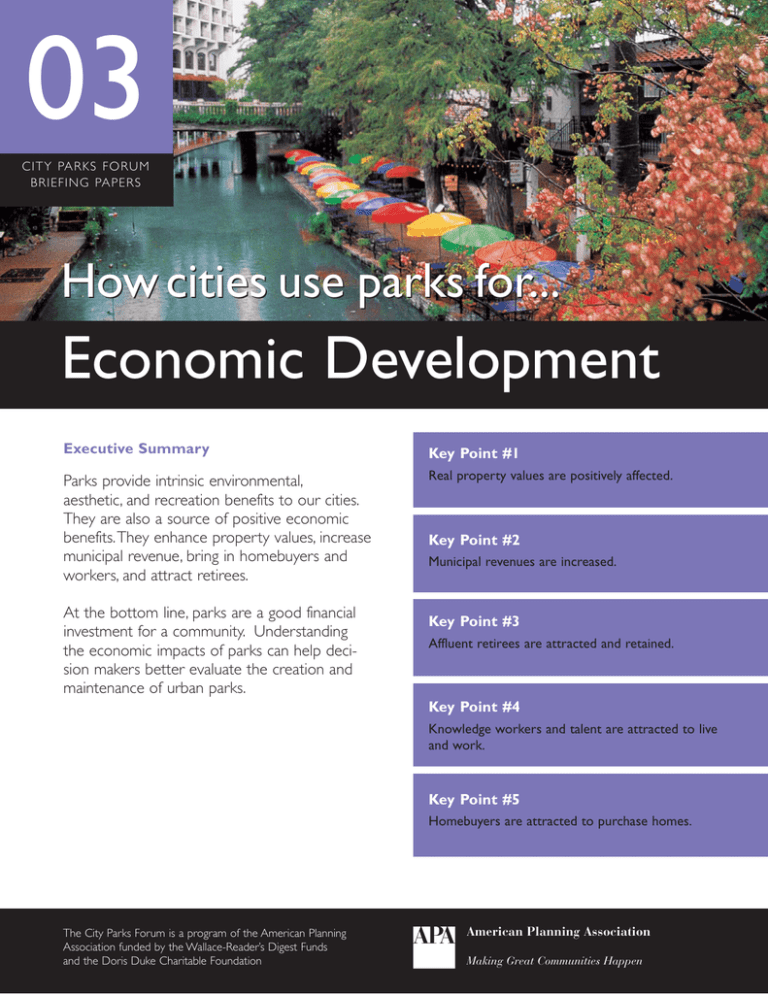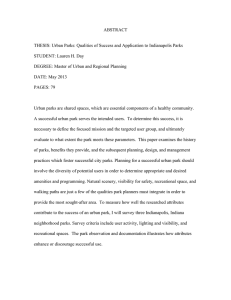How Cities Use Parks for Economic Development
advertisement

03 CITY PARKS FORUM BRIEFING PAPERS How cities use parks for... Economic Development Executive Summary Key Point #1 Parks provide intrinsic environmental, aesthetic, and recreation benefits to our cities. They are also a source of positive economic benefits.They enhance property values, increase municipal revenue, bring in homebuyers and workers, and attract retirees. Real property values are positively affected. At the bottom line, parks are a good financial investment for a community. Understanding the economic impacts of parks can help decision makers better evaluate the creation and maintenance of urban parks. Key Point #2 Municipal revenues are increased. Key Point #3 Affluent retirees are attracted and retained. Key Point #4 Knowledge workers and talent are attracted to live and work. Key Point #5 Homebuyers are attracted to purchase homes. The City Parks Forum is a program of the American Planning Association funded by the Wallace-Reader’s Digest Funds and the Doris Duke Charitable Foundation American Planning Association Making Great Communities Happen 03 CITY PARKS FORUM BRIEFING PAPERS Economic Development KEY POINT #1: KEY POINT #2: Real property values are positively affected. Municipal revenues are increased. More than 100 years ago, Frederick Law Olmsted conducted a study of how parks help property values. From 1856 to 1873 he tracked the value of property immediately adjacent to Central Park, in order to justify the $13 million spent on its creation. He found that over the 17-year period there was a $209 million increase in the value of the property impacted by the park. Another component of the Central Park study was an assessment of increased tax revenue as a result of the park. The annual excess of increase in tax from the $209 million in property value was $4 million more than the increase in annual debt payments for the land and improvement. As a result of building Central Park, New York City made a profit. As early as the 19th century the positive connection between parks and property values was being made. Olmsted's analysis shows the real dollar amount impact of parks. His study was not a unique situation, however. Several studies conducted over the last 20 years reaffirm his findings, in cities across the country. Below are more examples of how proximity to a park setting is connected to property values. Chattanooga,Tennessee: In the early 1980s this city was facing rising unemployment and crime, polluted air, and a deteriorating quality of life.To lure middle-class residents back, local government, businesses, and community groups decided to improve the quality of life by cleaning the air, acquiring open space, and creating parks and trails. As a result, property values rose more than $11 million, an increase of 127.5 percent. Atlanta: After Centennial Olympic Park was built, adjacent condominium prices rose from $115 to $250 a square foot. As noted on the Centennial Olympic Park website, “Thousands of people who have made the move to downtown Atlanta have chosen Centennial Olympic Park as their front yard.” www.centennialpark.com. Amherst, Massachusetts: Cluster housing with dedicated open space was found to appreciate at an annual rate of 22 percent, compared to a comparable conventional subdivision's rate of 19.5 percent.This translated in 1989 dollars to a difference of $17,100. 2 of 4 Increased property values and increased municipal revenues go hand in hand. Property tax is one of the most important revenue streams for cities. By creating a positive climate for increased property values, the tax rolls will benefit in turn. As shown with Central Park, parks can both pay for themselves and generate extra revenue. In addition, tax revenues from increased retail activity and tourism-related expenditures further increase municipal monies. Property Tax Benefits Chattanooga: Improvements in Chattanooga resulted in an increase in annual combined city and county property tax revenues of $592,000 from 1988 to 1996, an increase of 99 percent. (Lerner and Poole, 1999). Boulder:The presence of a greenbelt in a Boulder neighborhood was found to add approximately $500,000 in property tax revenue annually. Sales Tax Benefits Oakland, California:The presence of the East Bay Regional Park District is estimated to stimulate about $254 million annually in park-related purchases, of which $74 million is spent in the local East Bay economy. Shopping Districts: Surveys indicate that prices for products in districts with trees were on average about 11 percent greater than in no-tree districts; the quality of products were rated 30 percent higher than in areas with no sidewalk landscaping. Tourism-Related Benefits Atlanta: Centennial Olympic Park has an estimated 1.5 million visitors each year, attending 175 public events. San Antonio,Texas: Riverwalk Park, created for $425,000, is lined with outdoor cafes, shops, bars, art galleries, and hotels, and has overtaken the Alamo as the most popular attraction for the city's $3.5-billion tourism industry. AMERICAN PLANNING ASSOCIATION 03 CITY PARKS FORUM BRIEFING PAPERS Economic Development KEY POINT #3: KEY POINT #4: Affluent retirees are attracted and retained. Knowledge workers and talent are attracted to live and work. "There is a new, clean growth industry in America today— The industry is retirement migration" (Foreward in Longino, 1995, 7). "…cities are characterized by a sense of place, beauty in the natural environment, a mixed-use transportation system and a 24-hour lifestyle.These are the characteristics that will attract the creativity and brainpower that undergird the new economy." Steven Roulac, futurist,The Roulac Group. By the year 2050, according to the U.S. Census Bureau, approximately 1 in every 4 Americans will be 65 years of age or older, creating an affluent group of retirees with financial benefits, including Social Security, military benefits, and pension plans. With an average life expectancy of between 75 and 83 years, this is a significant population group, both in size and affluence. They are also mobile, moving to various locations across the country—places as diverse as northern Wisconsin and Michigan, the mountains of Colorado and Montana, and New England. Members of this mobile retiree cohort have been termed "GRAMPIES": (Growing [number of] Retired Active Monied People In Excellent Shape). GRAMPIES want communities that provide leisure and recreation amenities. In a study by Miller et al. (1994), a retiree sample was asked to review 14 features and indicate their importance in the decision to move.The first three in rank order were scenic beauty, recreational opportunities, and mild climate. A significant change has occurred in the American economy. Industry today is composed of smokeless industries, high technology, and service-sector businesses, collectively referred to as the "New Economy." The workers in the New Economy are selling their knowledge, as opposed to physical labor, as the main source of wealth creation and economic growth. These employees, referred to in studies as "knowledge workers" or "talent," work in a "footloose" sector—companies are not tied to a certain location in order to achieve a competitive advantage. What the companies are attached to is retaining their talent and attracting more talent. As a result, several studies have been conducted to determine what factors are important to talent when they are making employment decisions. A survey of 1,200 high technology workers in 1998 by KPMG found that quality of life in a community increases the attractiveness of a job by 33 percent. Retirees bring expendable income into their communities. If 100 retired households come to a community in a year, each with a retirement income of $40,000, their impact is similar to that of a new business spending $4 million annually in the community. (Crompton, p. 65). Knowledge workers prefer places with a diverse range of outdoor recreational activities, from walking trails to rock climbing. Portland, Seattle, Austin, Denver, and San Francisco are among the top cycling cities; they also are among the leaders in knowledge workers. They increase the tax base and are "positive" taxpayers, using fewer services than they pay for through taxes. For example, they pay taxes to school districts but do not send children there. Workers attracted to an area are then positioned to put money back into the local economy through jobs, housing, and taxes, which then contribute to parks. Retirees transfer significant assets into local investment and banking institutions, expanding the local deposit base that can be used for commercial and industrial financing. 3 of 4 AMERICAN PLANNING ASSOCIATION 03 CITY PARKS FORUM BRIEFING PAPERS Economic Development KEY POINT #5: Homebuyers are attracted to purchase homes. "Parks, ponds, bike paths." "Nearly five acres of woodland protected as a nature sanctuary" "My lake…my park…my home." The National Association of Home Builders found that 65 percent of home shoppers surveyed felt that parks would seriously influence them to move to a community. All around the U.S. real estate brokers and homebuilders are advocating parks as one of the top residential selling points. The desire to live near parks also translates into real dollars. According to Economics Research Associates (ERA), a 1991 survey in Denver found that 48 percent of residents would pay more to live in a neighborhood near a park or greenway. A 2001 survey by the National Association of Realtors (NAR) revealed that 57 percent of voters would choose a home close to parks and open space over one that was not. In addition, the NAR survey found that 50 percent of voters would be willing to pay 10 percent more for a house located near a park or protected open space. One of the most popular planned community models today is golf-course residential development. However, surveys have shown that the majority of people who live in golf course communities don't play golf regularly—as many as two-thirds, according to ERA.They are attracted to the dedicated open space, the expansive views, and the guarantee that both elements will stay the same. By promoting, supporting, and revitalizing urban parks, cities can help attract a significant portion of the homebuying community. Resources Association of Foreign Investors in Real Estate. December 11, 2000. "Ten U.S. Cities Among 20 in the World Poised to Reap Benefits of New Economy." Press Release:The Roulac Group. National Park Service. 1995. Economic Impacts of Protecting Rivers, Trails, and Greenway Corridors: A Resource Book. Washington, D.C.: NPS Rivers,Trails and Conservation Assistance. Fourth Edition. Center for Urban Horticulture. November 1998. "Trees in Business Districts: Positive Effects on Consumer Behavior!" Seattle, Wash.: University of Washington. Phillips, Patrick L. n.d. ERA Issue Paper: Real Estate Impacts of Urban Parks. Los Angeles: Economics Research Associates. Crompton, John L. November 2001. Parks and Economic Development. PAS Report No. 502. Chicago: APA. Florida, Richard. January 2000. "Competing in the Age of Talent: Quality of Place and the New Economy." Prepared for the R.K. Mellon Foundation, Heinz Endowments, and Sustainable Pittsburgh. Urban Land Institute. 1994. Golf Course Development and Real Estate. Washington, D.C.: Urban Land Institute. For further information on this paper, please contact the author, Megan Lewis, AICP, Assistant Director of The City Parks Forum, 312-786-6363; mlewis@planning.org Cover photo: San Antonio Riverwalk, courtesy of Alexander Garvin Foster, Mary. November 6, 1999. "Better homes have gardens, parks." New Orleans Times-Picayune. Handley, John. September 5, 1999. "Gold Medal." Chicago Tribune, Section 16, Real Estate. Harnik, Peter. 2000. Inside City Parks. Washington, D.C.: Urban Land Institute. Lerner, Steve and William Poole. 1999. The Economic Benefits of Parks and Open Space: How Land Conservation Helps Communities Grow and Protect the Bottom Line.The Trust for Public Land. City Parks Forum Briefing Papers Longino, C.F. Jr. 1995. Retirement Migration in America. Houston:Vacation Publications. This is one in a continuing series of briefing papers on how cities can use parks to address urban challenges.We hope the information here helps you to create great urban parks in your city. MacKay, Ned. December 21, 2000. "Putting a price on the value of open space." Contra Costa Times, Oakland, Cal. Please visit our website at www.planning.org/cpf to learn more about The City Parks Forum. Miller, W., et al. 1994. Retirement In-Migration Study. Mississippi State, Miss.: Southern Rural Development Center. 4 of 4 Copyright © 2002 by American Planning Association 122 S. Michigan Ave, Suite 1600, Chicago, IL 60603; www.planning.org. AMERICAN PLANNING ASSOCIATION
![’s parks! Drinking water for [your council]](http://s2.studylib.net/store/data/015536248_1-deb9fc91be22600fb864bde62cc406aa-300x300.png)
